How to Create a Wildlife Sanctuary With Native Plants
Use North American native plants to create a wildlife sanctuary. Wildlife such as bees, beetles, bats, butterflies, birds, and others are crucial to plant pollination. This is especially important for plant reproduction. Pollinating wildlife carry pollen as they travel through the garden. These wildlife pollinators transfer pollen material for reproduction of flowering plants. They bounce from one flower to the next drinking nectar and eating pollen. Pollen is transferred to a flower head from the previous flower head. As gardeners, we need to be mindful of this pollination process. It is vital for plant reproduction and production of berries, fruits, nuts, and seeds.
Essentials to Create a Wildlife Sanctuary in your Garden
Select a location for your wildlife sanctuary that provides both Sun and shade. Create a wildlife sanctuary by providing basic food, water, and shelter. Wildlife sanctuaries should contain a variety of food sources and reliable water source. Shelter in a sanctuary, protects wildlife from the weather elements and predators. This is vital for survival of many wildlife species. In many instances, shelter can be used for nesting and as a place for raising offspring.
One critical food source for wildlife is the surrounding plant life habitat. In the US, the ideal plant life for wildlife is North American native plants. This refers to plants on the continent prior to European settlement. Plants that have been in North America for hundreds of years. These plants are better suited for North American wildlife. Native plants readily adapt to local climate conditions and existing soil conditions. Native plant species are the best sources of food for our wildlife. Over the hundreds of years they have provided nectar, pollen, seeds, and other food for native butterflies, insects, bees, birds, and other wildlife.
Consider these native plants for creating a wildlife sanctuary. These native plant species provide nectar, pollen, seeds for hungry native bees, insects, butterflies, birds, and other wildlife. Below are 35 native plants that native wildlife will relish in your garden. Take a look and let us know what you think.
Sun Loving Native Perennials
- Golden Alexanders or Zizia Aurea
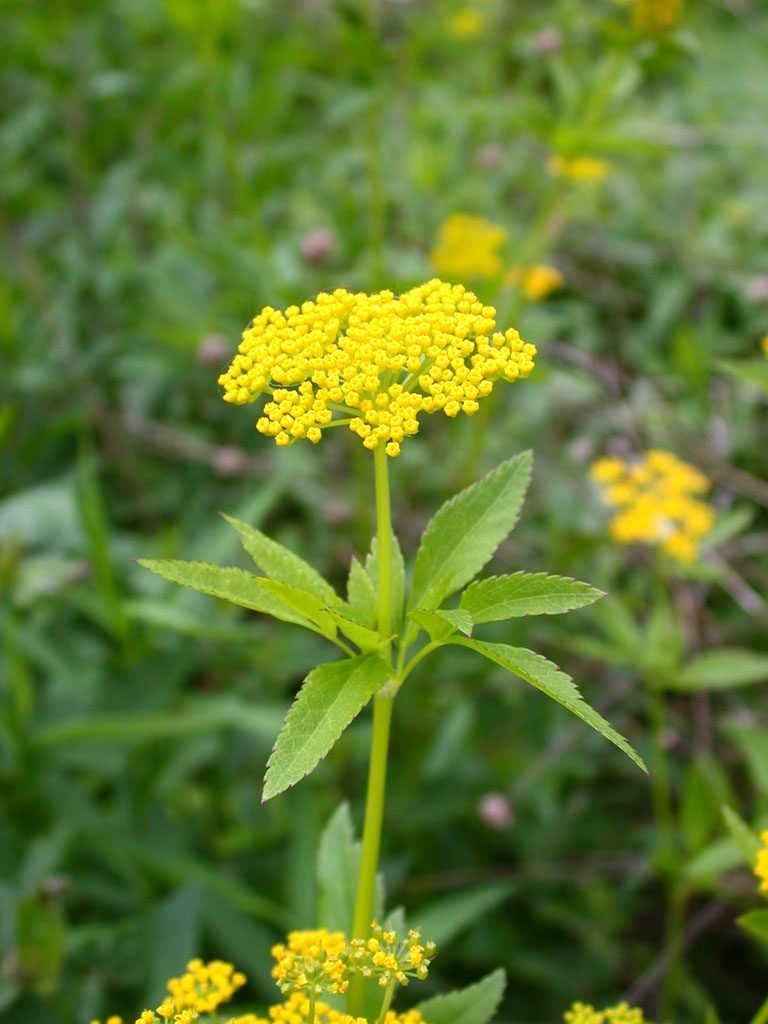
Golden Alexanders or Zizia Aurea, Golden Zizia has small, yellow flowers that appear in April, May, and June. Topping out at 3 feet tall, Golden Alexanders grows in zones 3 to 8 in full Sun to part Sun and part shade. Easy to grow and self-seeding Golden Alexanders provides nectar to short-tongued insects. Its leaves are a food source to Black Swallowtail caterpillars.
2. Rudbeckia Goldsturm or Black-eyed Susan
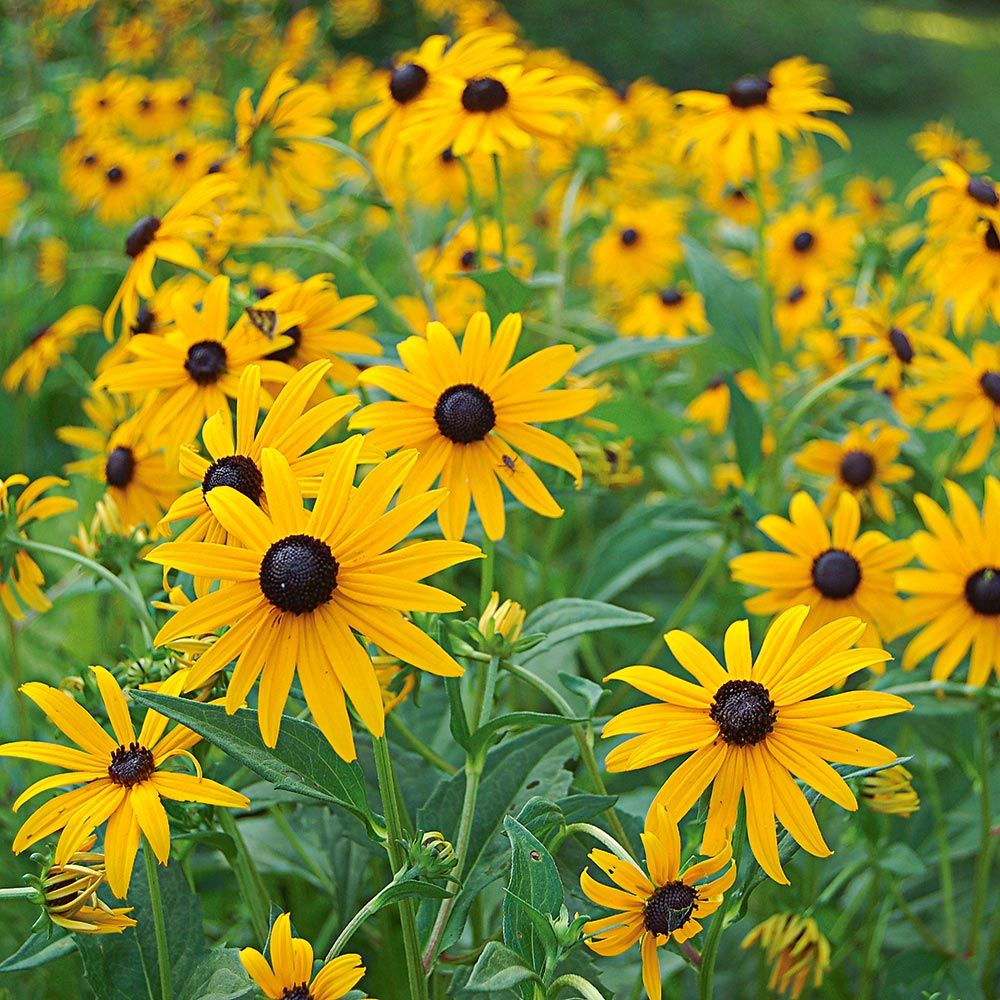
Rudbeckia Goldsturm or Black-eyed Susan has bright golden yellow flowers on an upright plant topping out at 40 inches. Sun loving Goldsturm grows in zones 3 to 8 blooms from July to October. A classic native Black-eyed Susan plant.
3. Coreopsis Sienna Sunset or Tickseed

Coreopsis Sienna Sunset or Tickseed has orange petals overlaid with burnt sienna colors aging to a rich salmon which blooms from June to September. Deer resistant Sienna Sunset grows in zones 5 to 9 reaching 16 to 20 inches tall. Sun loving Sienna Sunset can be cut back after initial bloom to promote repeat blooms. Native to the Southeast US and Mexico.
2 Monarda or Bee Balm Native plants for a Wildlife Sanctuary
4. Monarda Coral Reef or Bee Balm
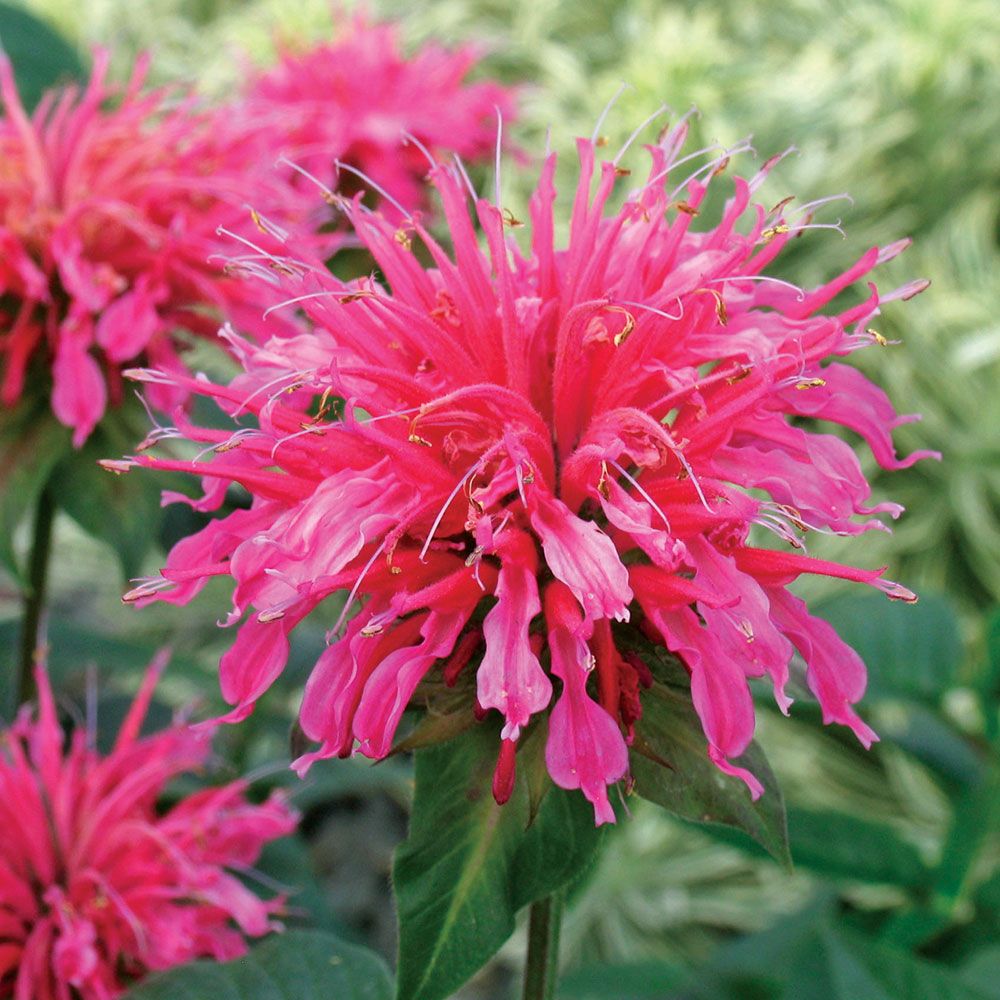
Monarda Coral Reef or Bee Balm has hot pink flowers with a touch of coral tones on aromatic foliage in late Summer. Butterfly and hummingbird loving Monarda Coral Reef grows in zones 4 to 8 in full Sun to part Sun and part shade. Mildew resistant Coral Reef reaches 36 to 42 inches in height and blooms in July and August.
5. Monarda Fireball or Bee Balm
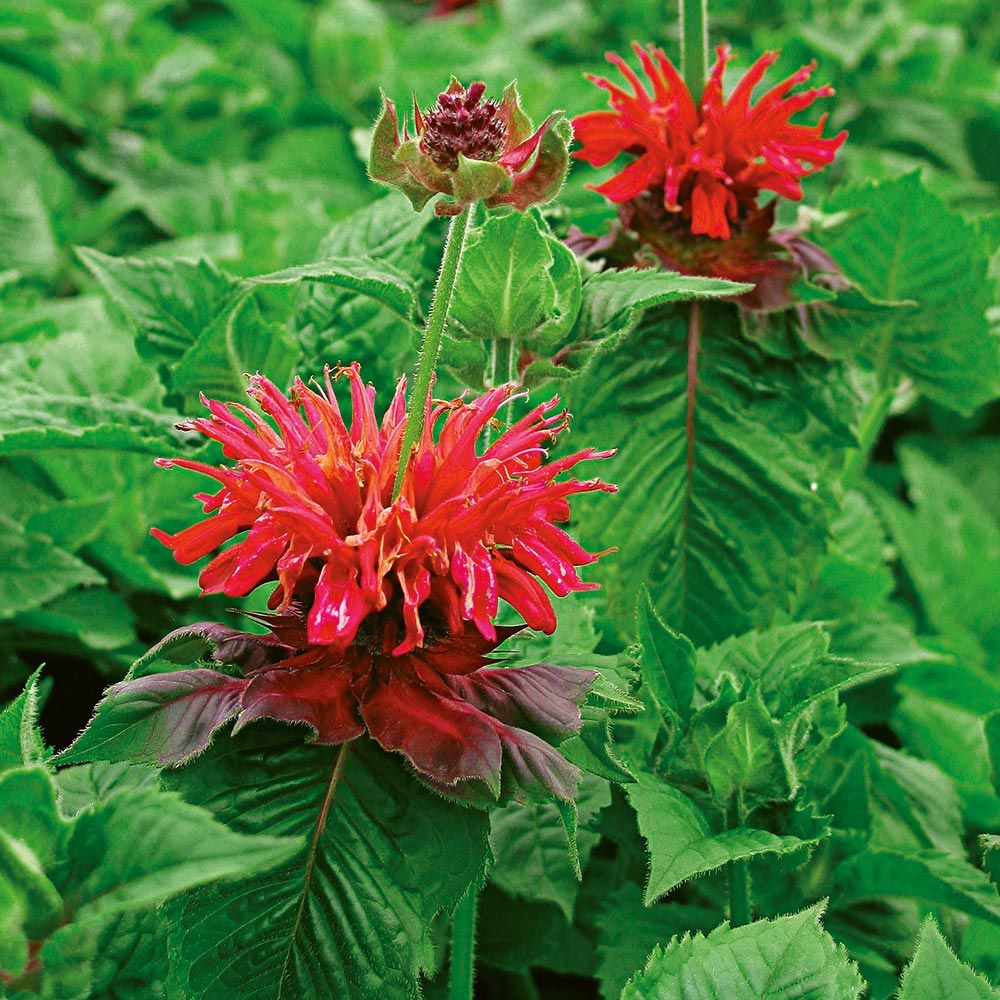
Monarda Fireball or Bee Balm has deep scarlet flowers that bloom in July and August. Fireball grows in zones 4 to 8 in full Sun to part Sun and part shade, reaching 12 to 18 inches tall. A dwarf Monarda, Fireball has enormous hummingbird appeal with fragrant foliage.
6. Meadow Blazing Star or Liatris
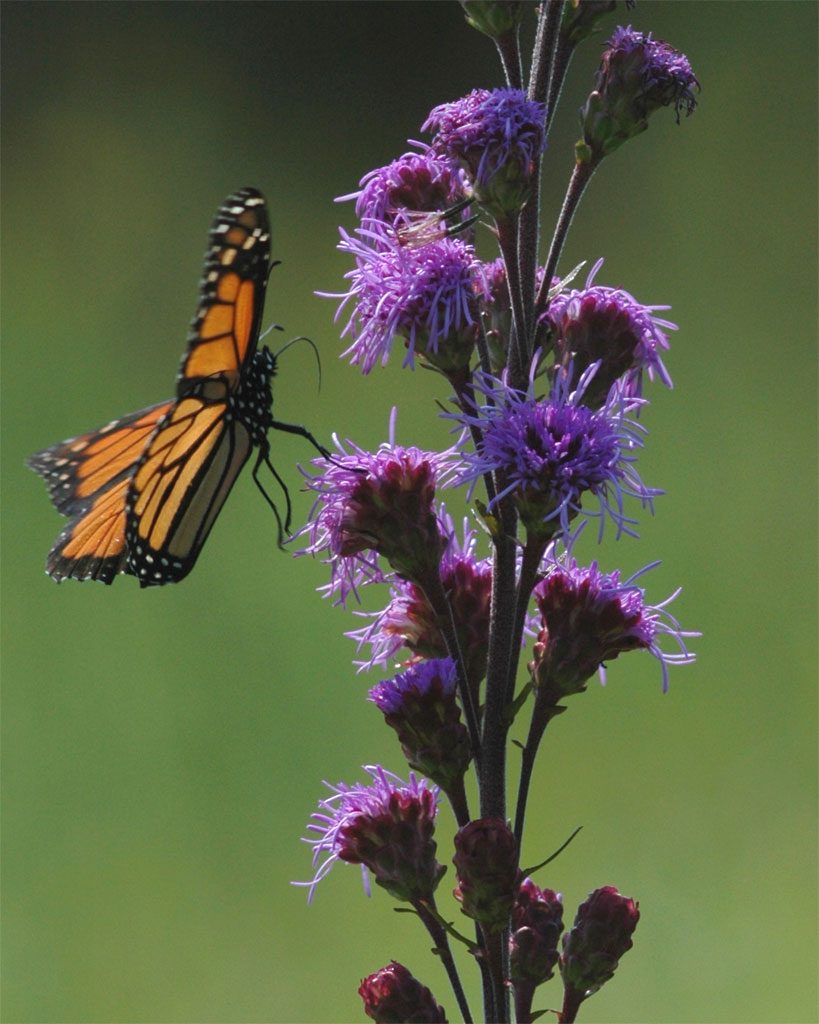
Meadow Blazing Star or Liatris is sometimes considered the ultimate Monarch Butterfly magnet with its purple blossoms. Topping out at 5 feet tall Meadow Blazing Star grows in zones 3 to 7 in full Sun to part Sun and part shade. Blooming in August and September, Meadow Liatris draws Monarchs and other butterflies to its long-lasting flowers. Later in the season, birds are drawn to the seeds.
7. Liatris Alba or Blazing Star
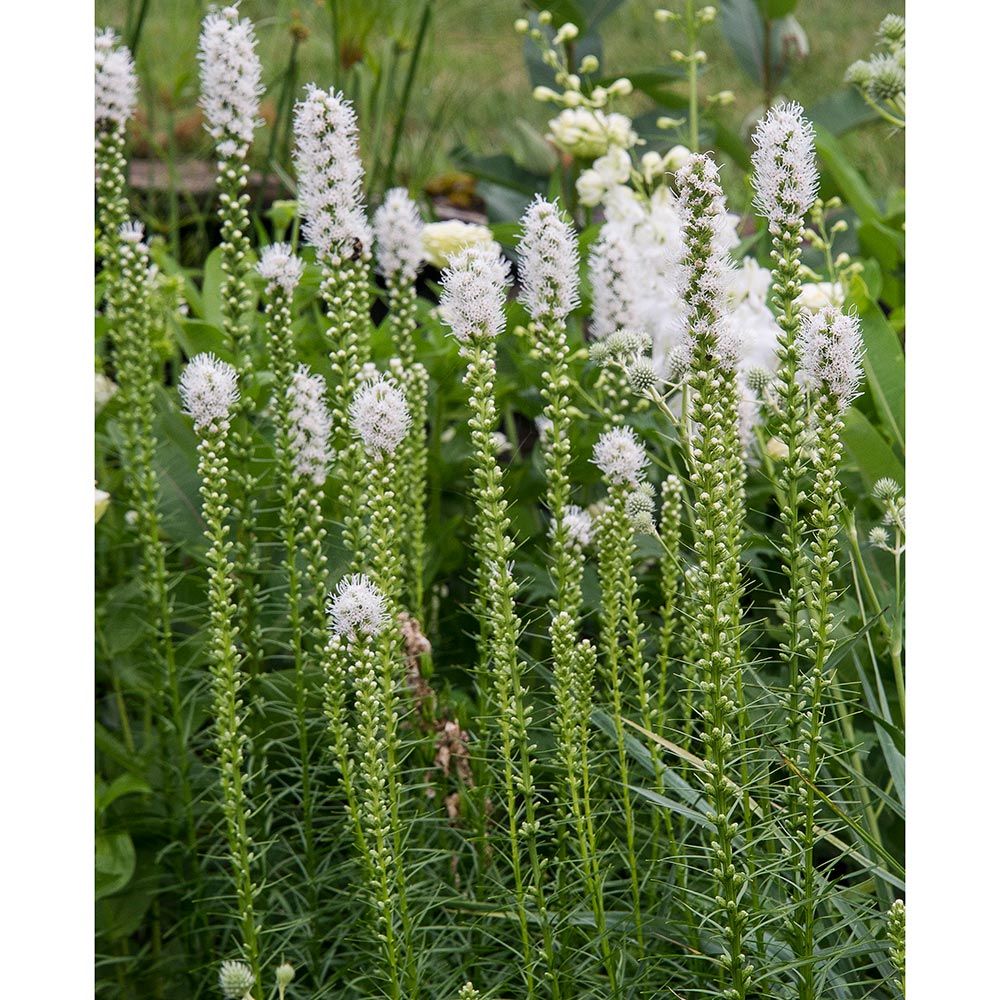
Sun loving Liatris Alba or Blazing Star has white blooms in July and August. Liatris Alba grows in zones 4 to 8 in full Sun reaching 3 to 4 feet tall. Deer resistant Liatris Alba likes well draining soil and attract butterflies as well other pollinators. Great for cut flowers, flower drying, or use along a garden border. Alba will self-sow if not deadheaded.
8. Heliopsis helianthoides or Early Sunflower
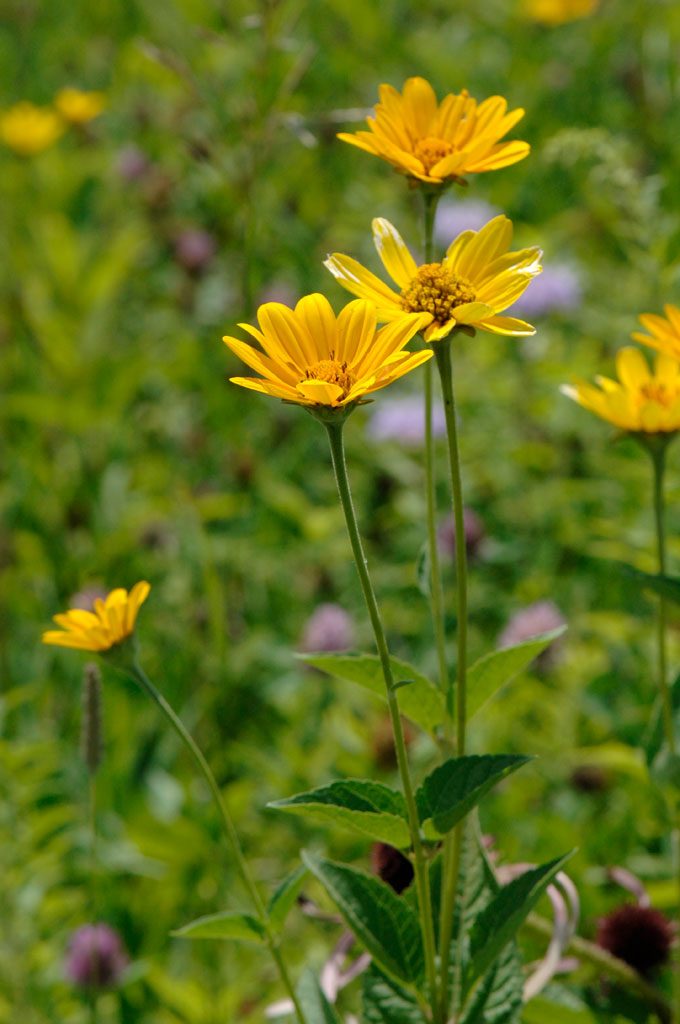
Heliopsis helianthoides or Early Sunflower has yellow blooms in June, July, August, and September. Tops out at 5 feet tall! Early Sunflower grows in zones 3 to 8 in full Sun to part Sun and part shade. Blooms profusely on thin stems. Simply gorgeous!
2 Wild Indigo or Baptisia Native plants for a Wildlife Sanctuary
9. Blue Wild Indigo or Baptisia
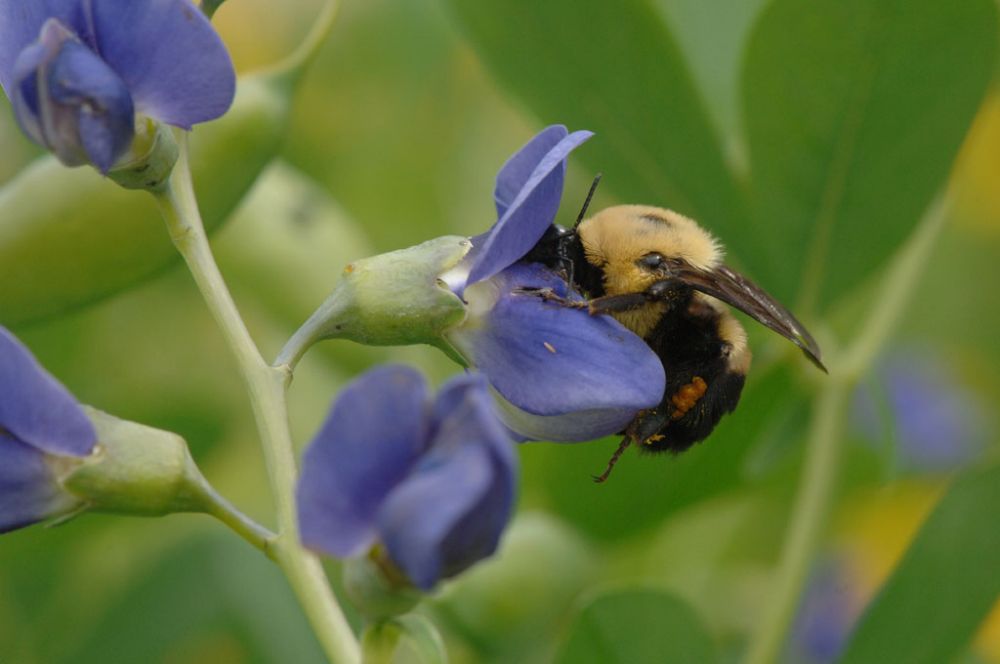
Blue Wild Indigo or Baptisia, Blue False Indigo has deep blue flowers in May, June, and July. Tops out at 4 feet. Blue Wild Indigo grows in zones 4 to 9 in full Sun to part Sun and part shade.
10. Cream Wild Indigo or Baptisia
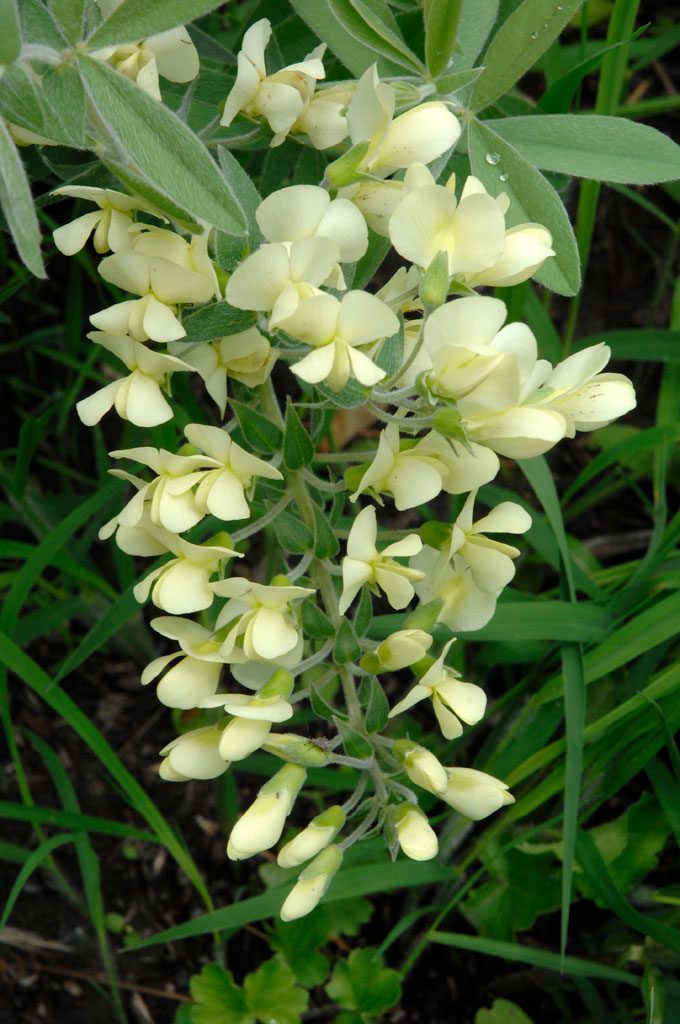
Cream Wild Indigo or Baptisia, Cream False Indigo has showy cream to pale yellow blooms from May to June. Tops out at 2 feet Cream Wild Indigo grows in zone 4 to 9 in full Sun to part Sun and part shade. Cream Wild Indigo flowers turn into light green seed pods then to blue-black pods in the Fall. Good stuff for pollinators! Cream Wild Indigo are essential for queen bumblebees.
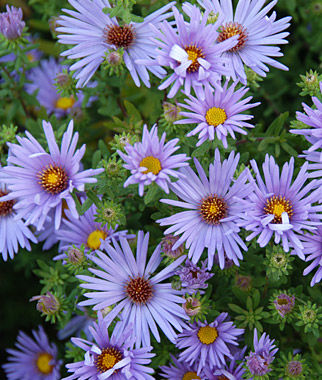
Aster Raydon’s Favorite has daisy-like lavender blue flowers on gray-green foliage that bloom in the Fall. Sun loving Raydon’s Favorite grows in zones 3 to 8 reaching 24 to 36 inches tall. Easy to grow and deer resistant Raydon’s Favorite is aromatic and attracts butterflies. Can be used in garden beds and borders.
12. Vibrant Dome Aster or New England Aster
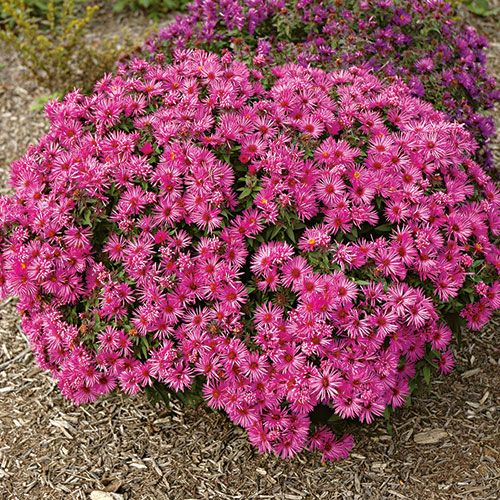
Vibrant Dome Aster or New England Aster have raspberry pink daisies, a hot summer color for Fall plantings. Topping out at 18 to 20 inches Vibrant Dome grows in zones 3 to 8 in full Sun. Blooming in September and October, Vibrant Dome likes evenly moist soil.
3 Echinacea or Coneflower Native plants for a Wildlife Sanctuary
13. Fragrant Angel Echinacea or Coneflower
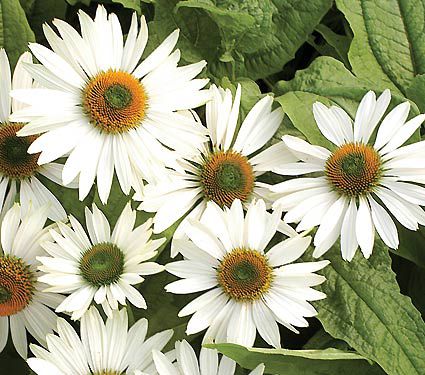
Fragrant Angel Echinacea or Coneflower has large, fragrant white flowers blooming profusely throughout the Summer months. Sun loving Fragrant Angel grows in zones 4 to 9, reaches 40 inches tall, and blooms June to August. Butterfly attracting Fragrant Angel thrives in average soils, hot dry conditions, cold hardy, and makes great cut flowers. In the Fall, the flower head center cone turns black as seeds mature which attracts goldfinches.
14. Echinacea Butterfly Purple Emperor or Coneflower
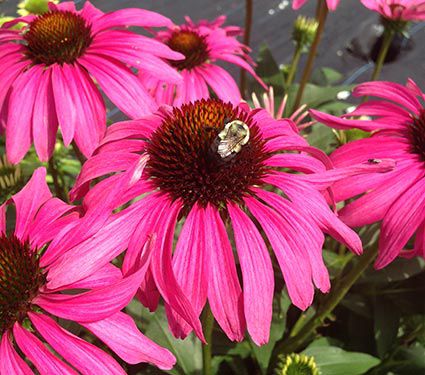
Compact Echinacea Butterfly Purple Emperor or Coneflower has bold, rosy purple blossoms with petal tips shifting to lighter pink as the flowers mature. Topping out at 15 to 18 inches Purple Emperor grows in zones 4 to 8 in full Sun. Deer resistant Purple Emperor blooms June through August attracting pollinators including birds and butterflies. Perfect for small gardens, small spaces, formal borders, and cottage gardens. An excellent choice for a wildlife sanctuary!
15. Echinacea Confections Butterfly Kisses or Coneflower
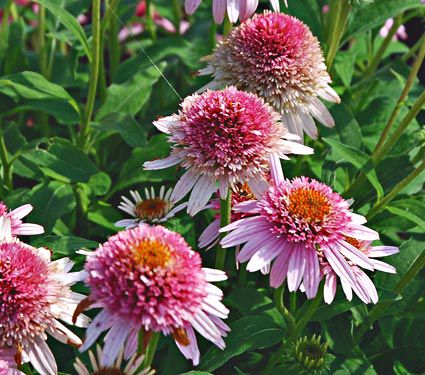
Echinacea Confections Butterfly Kisses or Coneflower has 3 inch double Pom Pom flowers with a showy central cone. The cone, surrounded by pink ray petals, begins lime green then bright pink and gold as Summer passes. Deer resistant Butterfly Kisses grows in zones 4 to 8 reaching 12 to 18 inches tall. Sun loving Butterfly Kisses blooms June to August. An ideal coneflower for small gardens, small spaces, or terrace containers.
16. Phlox Bright Eyes or Garden Phlox
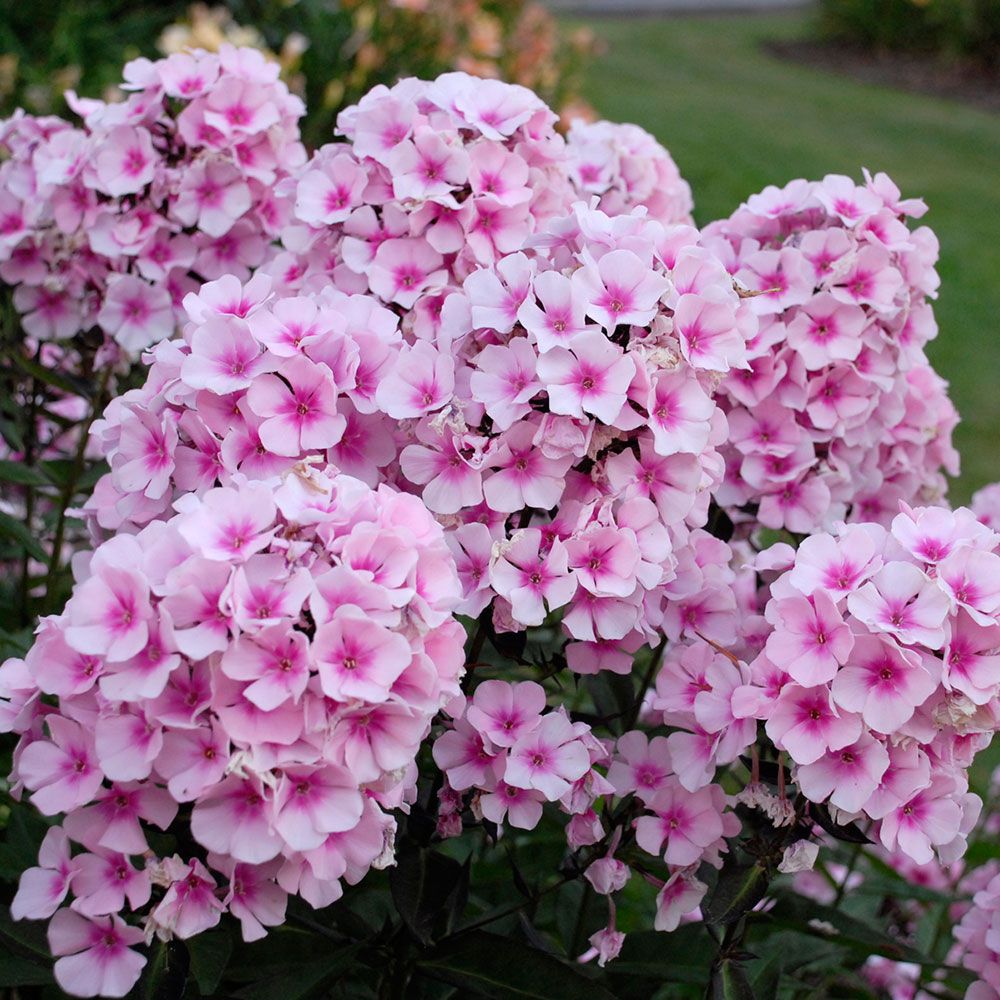
Phlox Bright Eyes or Garden Phlox has pale pink petals with a crimson eye that blooms in July and August. Topping at 36 inches Bright Eyes grows in zones 3 to 7 in full Sun. Fragrant Phlox Bright Eyes can be used as cut flowers.
17. Blue Paradise Phlox or Garden Phlox
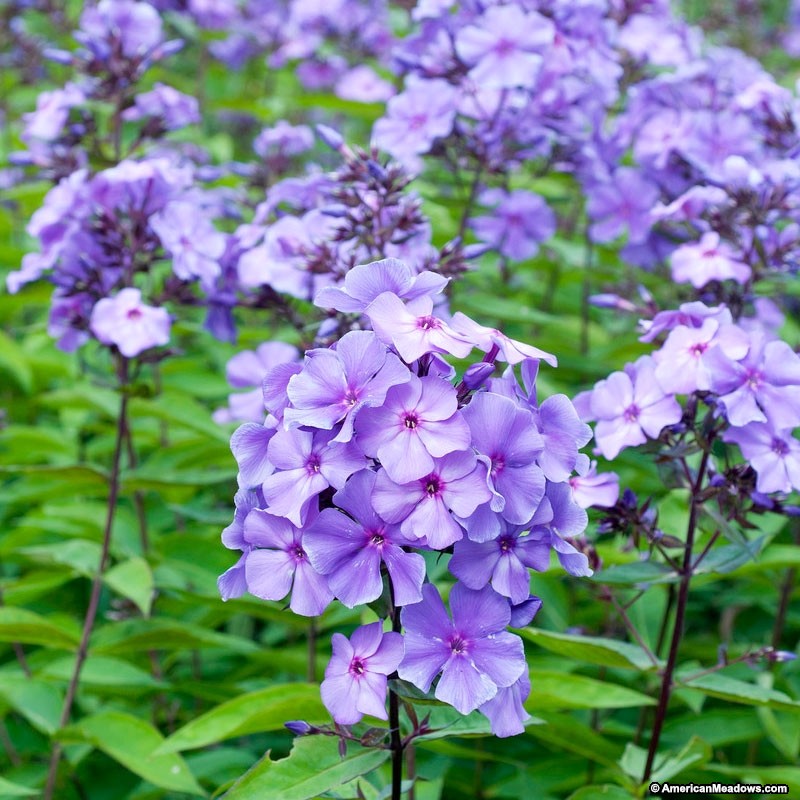
Blue Paradise Phlox or Garden Phlox has unique true blue blooms that deepen to violet blue then fade to original color as evening arrives. Sun loving Blue Paradise Phlox grows in zones 4 to 8 reaching 24 to 36 inches tall. Highly fragrant Blue Paradise Phlox blooms mid to late Summer, attracts butterflies and hummingbirds, and can be used as cut flowers. A native perennial that is easy to grow with foliage resistant to mildew.
3 Milkweed Native plants for a Wildlife Sanctuary
18. Asclepias Verticillata or Milkweed
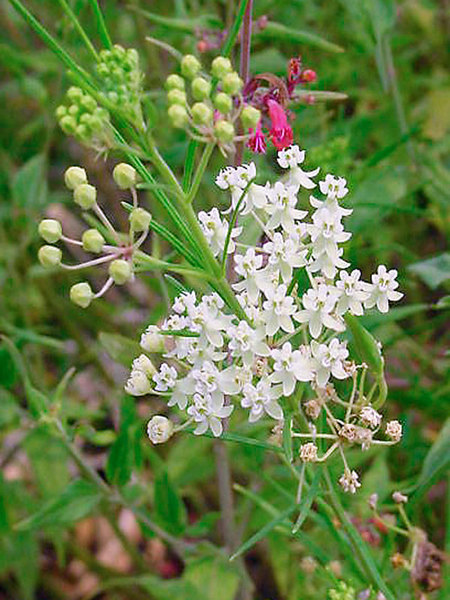
Butterfly loving Asclepias Verticillata or Milkweed has white clusters of flowers with grey-green foliage that turns yellow-orange in the Fall. Fragrant Asclepias Verticillata grows in zones 4 to 8 in full Sun reaching 12 to 24 inches tall. Deer resistant and cold hardy Milkweed blooms early to late Summer, and likes normal, clay, sandy, or acidic soil. Native Milkweed is a food source for butterfly larvae. Milkweed is a nectar source and egg host plant for Monarch butterflies. Beneficial for pollinators, attracts butterflies, and hummingbirds. Low maintenance and tolerant of dry hot sites and wet sites. For attracting more pollinators, plant in larger groups.
19. Asclepias Tuberosa or Butterfly Milkweed
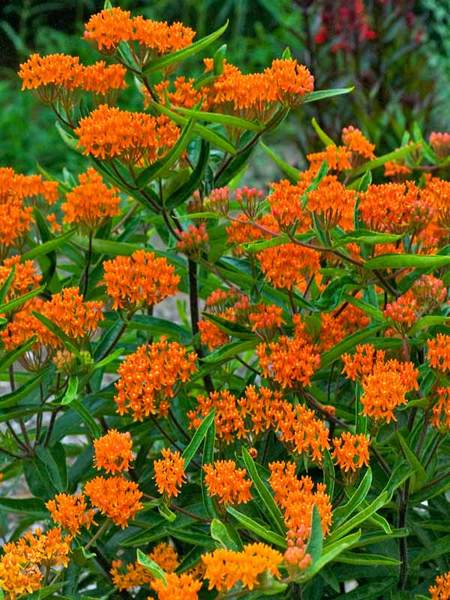
Asclepias Tuberosa or Butterfly Milkweed has intense tangerine orange blooms that invites droves of butterflies in early to late Summer. Deer resistant Butterfly Milkweed grows in zones 3 to 9 in full Sun, reaches 18 to 24 inches tall. Native to eastern North America, Butterfly Milkweed once established requires little care. A Monarch butterfly host plant with green seed pods that is beneficial for all pollinators. Received a 2017 Perennial Plant Association Plant of the Year award. Attracts butterflies and hummingbirds and tolerant of hot dry sites and seaside/salt sites.
20. Asclepias incarnata or Soulmate Swamp Milkweed
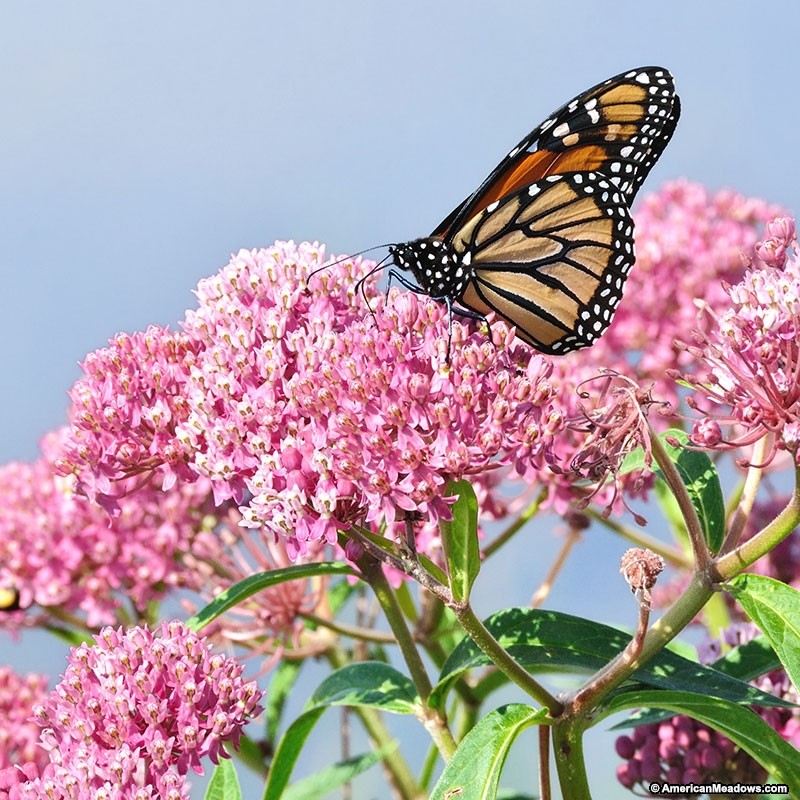
Asclepias incarnata or Soulmate Swamp Milkweed has cherry pink blooms with white centers in mid to late Summer. Deer and rabbit resistant Soulmate Swamp grows in zones 3 to 9. Sun loving Milkweed tops at 24 to 36 inches tall. An essential North American native, Swamp Milkweed has a sweet vanilla fragrance enticing Monarch butterflies and other pollinators. Ideal for small gardens, small spaces, attracts hummingbirds, bee-friendly, and tolerates wet sites.
21. Georgia Peach Heuchera or Coral Bells
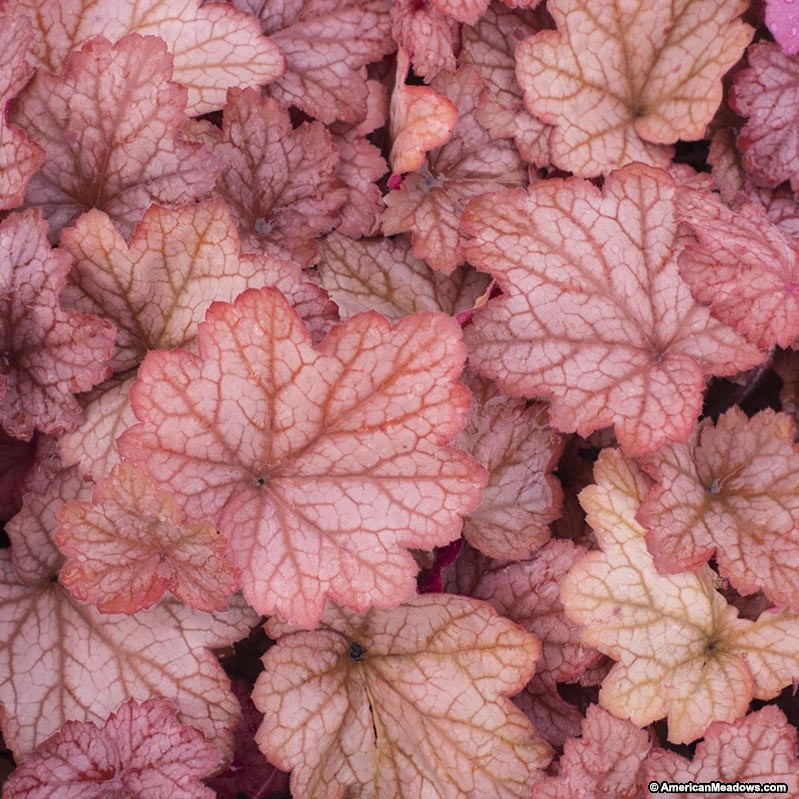
Georgia Peach Heuchera or Coral Bells has peach colored leaves with silvery color that deepens to a rosy pink-purple in the Fall. Blooming early to mid Summer Georgia Peach has creamy white bell shaped floral plumes. Topping out at 12 to 14 inches Georgia Peach grows in zones 4 to 9 in full Sun to part Sun and part shade. Deer and rabbit resistant Georgia Peach attracts butterflies and hummingbirds, good for container gardening, and small space gardening.
22. Great Blue Lobelia or Cardinal Flower
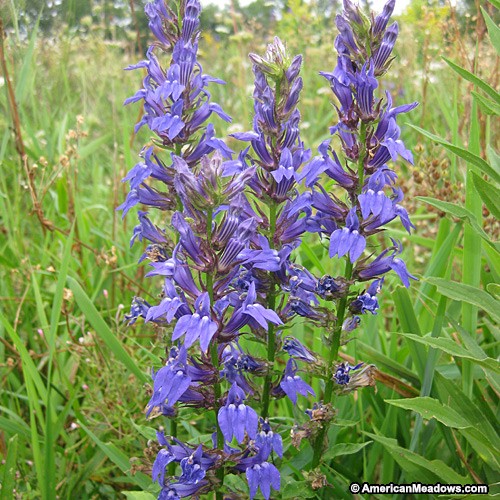
Butterfly and hummingbird loving Great Blue Lobelia or Cardinal Flower has light blue blooms in mid to late Summer. Great Blue Lobelia grows in zones 4 to 9 in full Sun to part Sun and part shade to full shade, growing 24 to 36 inches tall. Deer and rabbit resistant Great Blue Lobelia is bee friendly providing nectar to hungry little bees. An easy to grow native that is cold hardy, can be used for cut flowers, and is tolerant of wet sites. An excellent native plant to create a wildlife sanctuary!
Part Sun and Part Shade Native Perennials
23. Red Lobelia Cardinalis or Cardinal Flower
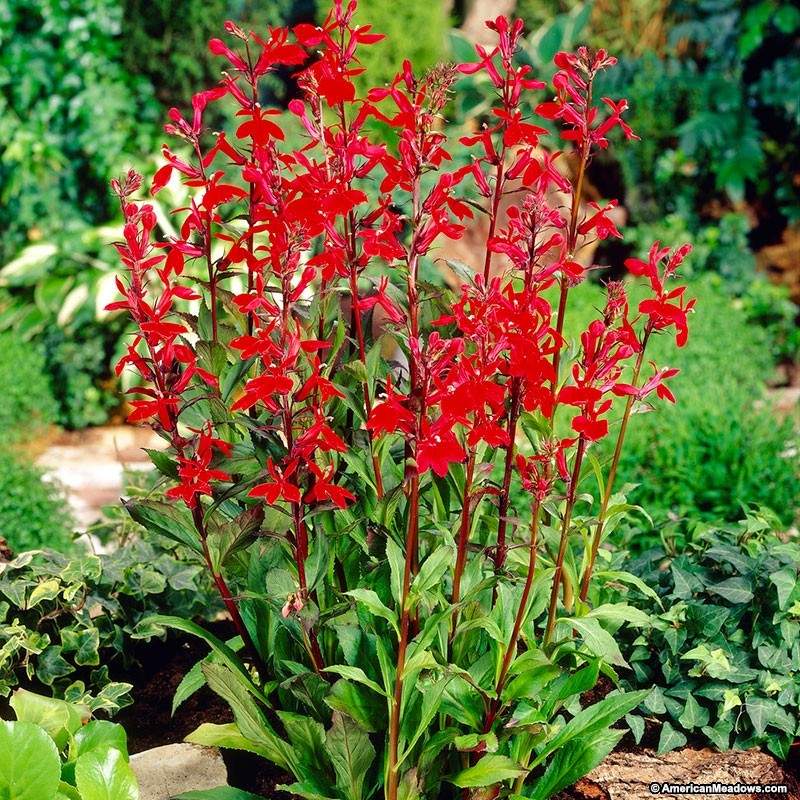
Red Lobelia Cardinalis or Cardinal Flower, a hummingbird favorite, has tall, vivid red flower spikes midSummer to Fall. Bold Red Lobelia grows in zones 3 to 9 in half Sun and half shade and tops out at 30 to 36 inches. Butterfly and hummingbird loving Red Lobelia is deer resistant, and tolerant of wet sites. Can be used as cut flowers but why not save them for our pollinator friends.
Shade Loving Native Perennials
24. Blue Moon Woodland Phlox or Wild Sweet William
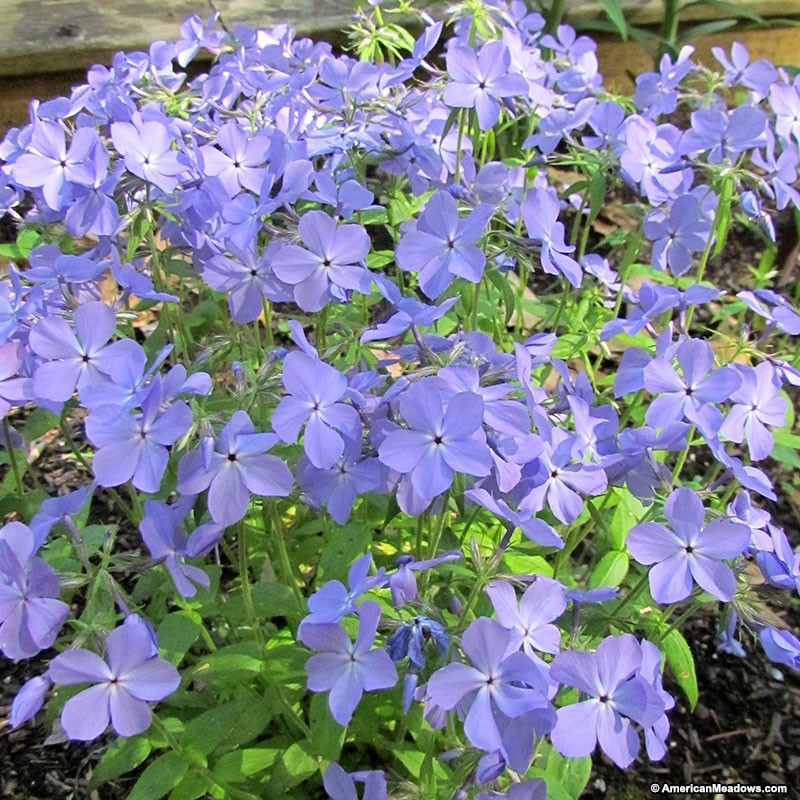
Blue Moon Woodland Phlox or Wild Sweet William, a native Phlox groundcover of rich violet-blue blooms above green foliage. Fragrant Blue Moon grows in zones 3 to 8 in part Sun and part shade to full Shade. Grows 8 to 12 inches tall and blooms April and May. Deer resistant Blue Moon attracts butterflies and hummingbirds. Ideal for a rock garden or shady garden area.
3 Trillium or Wake Robin Native plants for a Wildlife Sanctuary
25. White Trillium or Wake Robin
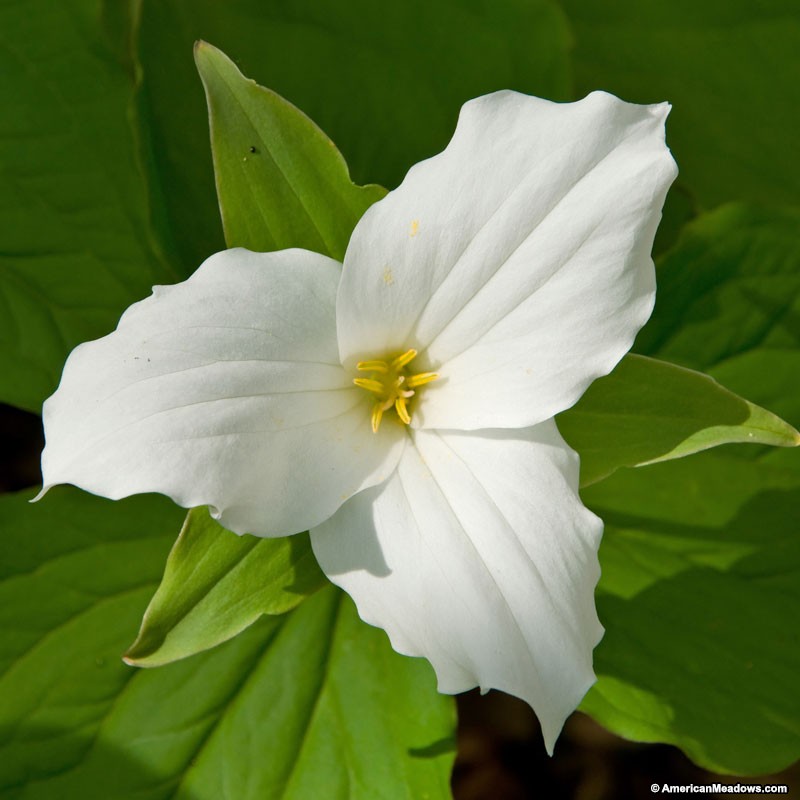
White Trillium or Wake Robin has large white flowers that fade to pale pink blooming in mid to late Spring. White Trillium grows in zones 4 to 8 in part Sun and part shade to full shade. Grows 12 to 14 inches tall and is rabbit resistant. A woodland wildflower, White Trillium spreads slowly but is worth the wait.
26. Red Trillium or Purple Trillium, Wake Robin
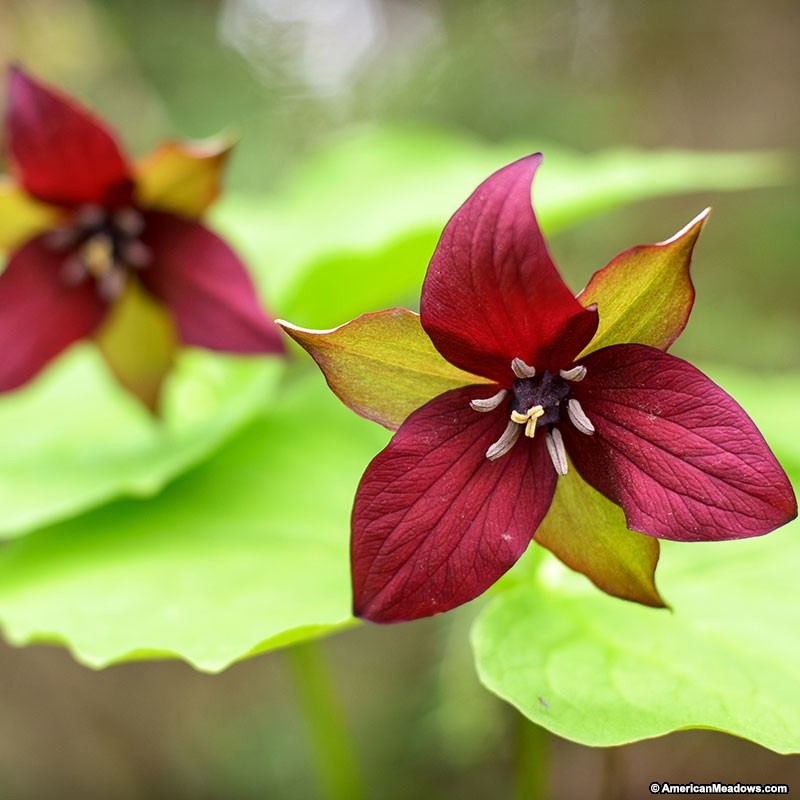
Red Trillium or Wake Robin is a woodland wildflower with three petal burgundy flowers that blooms in mid to late Spring. After blooming, blooms form berries that wildlife love to munch on. Red Trillium grows in zone 4 to 8 in part Sun and part shade to full Shade. Tops out at 6 to 18 inches tall. Prefers moist shade and rich soil, fragrant Red Trillium is deer and rabbit resistant. Ideal for river or stream floodplains, and rocky slopes. Sometimes called Stinking Benjamin because of the flower’s unpleasant odor but still very striking colors.
27. Painted Trillium or Wake Robin
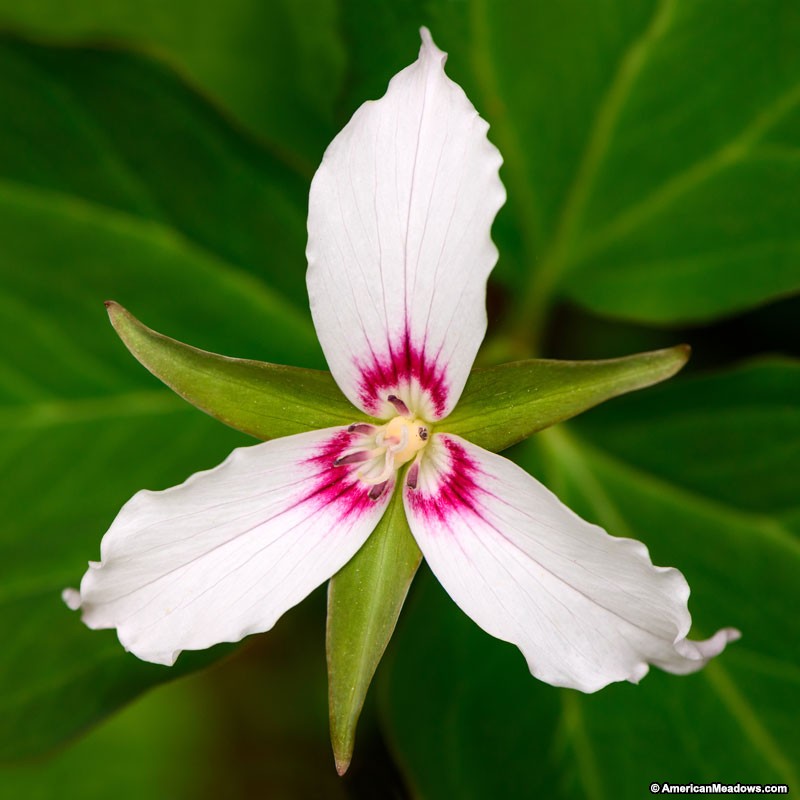
A woodland wildflower, Painted Trillium or Wake Robin has white petals with magenta-red center burst blooms mid to late Spring. Painted Trillium grows in zones 3 to 8 in part Sun and part shade to full shade. Tops out between 8 to 18 inches. Deer and rabbit resistant Painted Trillium likes acidic soil. A great selection for pine woods, along rivers, stream floodplains, or rocky slopes.
28. Mertensia virginica or Virginia Bluebells
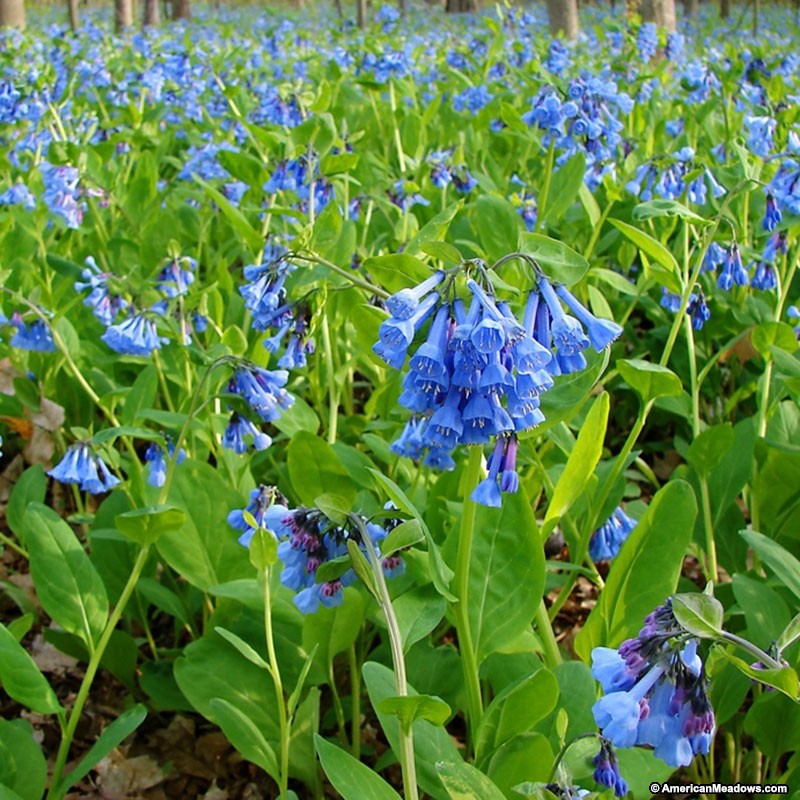
Mertensia virginica or Virginia Bluebells has pastel pink buds that open vivid, true blue blooms with blue-green foliage early to late Spring. Virginia Bluebells grows in zones 3 to 8 in part Sun and part shade to full shade. Reaching 18 to 24 inches tall. Deer resistant Virginia Bluebells tolerates wet sites. Ideal for part and full-shade woodland gardens that pollinators adore.
29. Indian Pink or Woodland Pinkroot

Indian Pink or Woodland Pinkroot has trumpet shaped blooms with a red exterior, yellow inside, and a unique flare at the top that forms a star shape. Blooms late Spring to early Summer. Indian Pink grows in zones 6 to 9 in part Sun and part shade to full shade. Tops out at 12 to 18 inches. Butterfly and hummingbird loving Indian Pink is an easy to grow woodland perennial that spreads easily. Likes moist and well-draining soils.

Marginal Woodfern an evergreen fern with rich blue-green fronds. Marginal Woodfern grows in zones 3 to 8 in part Sun and part shade to full shade. Topping out at 18 to 24 tall. Deer resistant Marginal Woodfern is tolerant of poor, rocky, and dry soil. This fern makes a great groundcover.
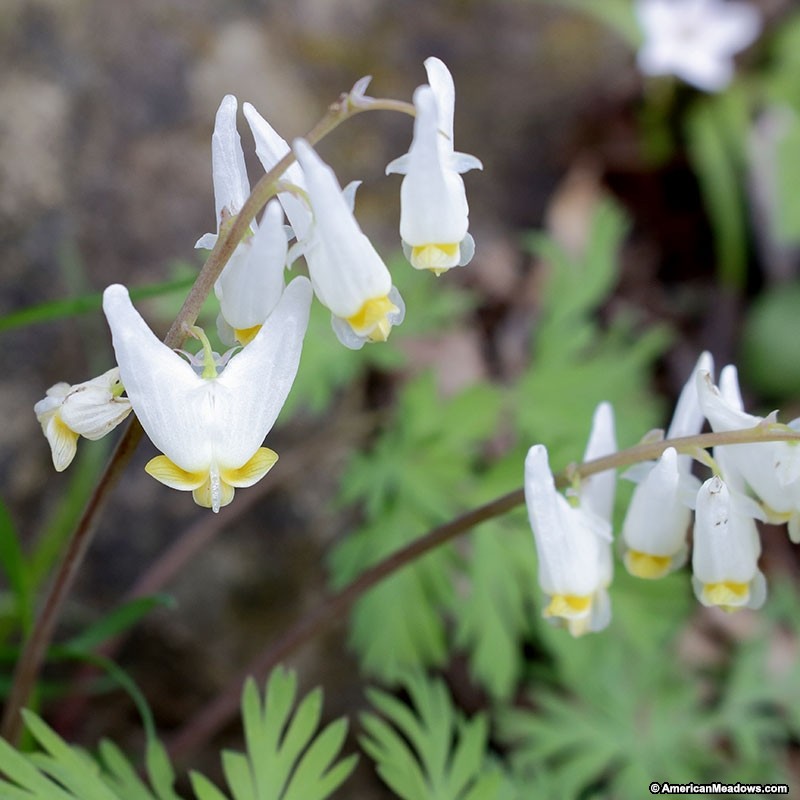
Bee friendly Dutchman’s Breeches has creamy white flowers that resemble a pair of upside-down pants or breeches. A wildflower version of a Bleeding Heart, Dutchman’s Breeches blooms in early Spring. Dutchman’s Breeches grows in zones 3 to 8 in part Sun and part shade to full shade. Grows 8 to 10 inches tall. Deer and rabbit resistant Dutchman’s Breeches has blue green foliage.
32. Shooting Star
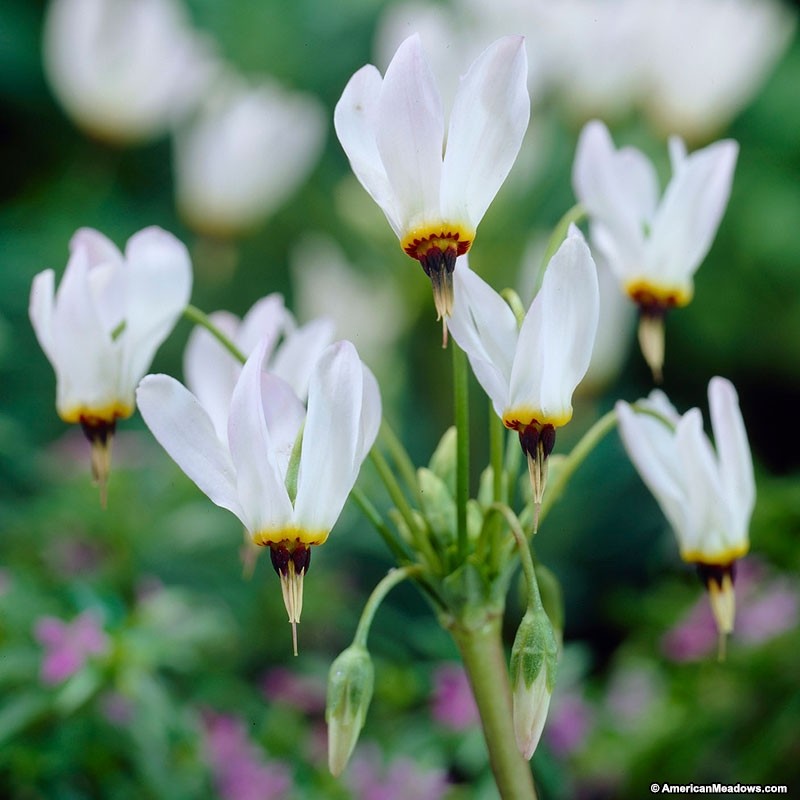
Bee friendly Shooting Star has dart-like blossoms with peeled-back petals that dangle from tall stems. The petals vary in shades of white and pink with the white being more common. Two bands – one deep purple, the other golden yellow, circle the base of each flower. The color combinations along with the shape, makes Shooting Star very appealing. Blooms in late Spring to early Summer. Tops out 10 to 12 inches tall Shooting Star grows in zones 4 to 8 in part Sun and part shade to full shade. Native Shooting Star is ideal for small spaces or small garden spaces.
33. Dwarf Larkspur or Wild Delphinium
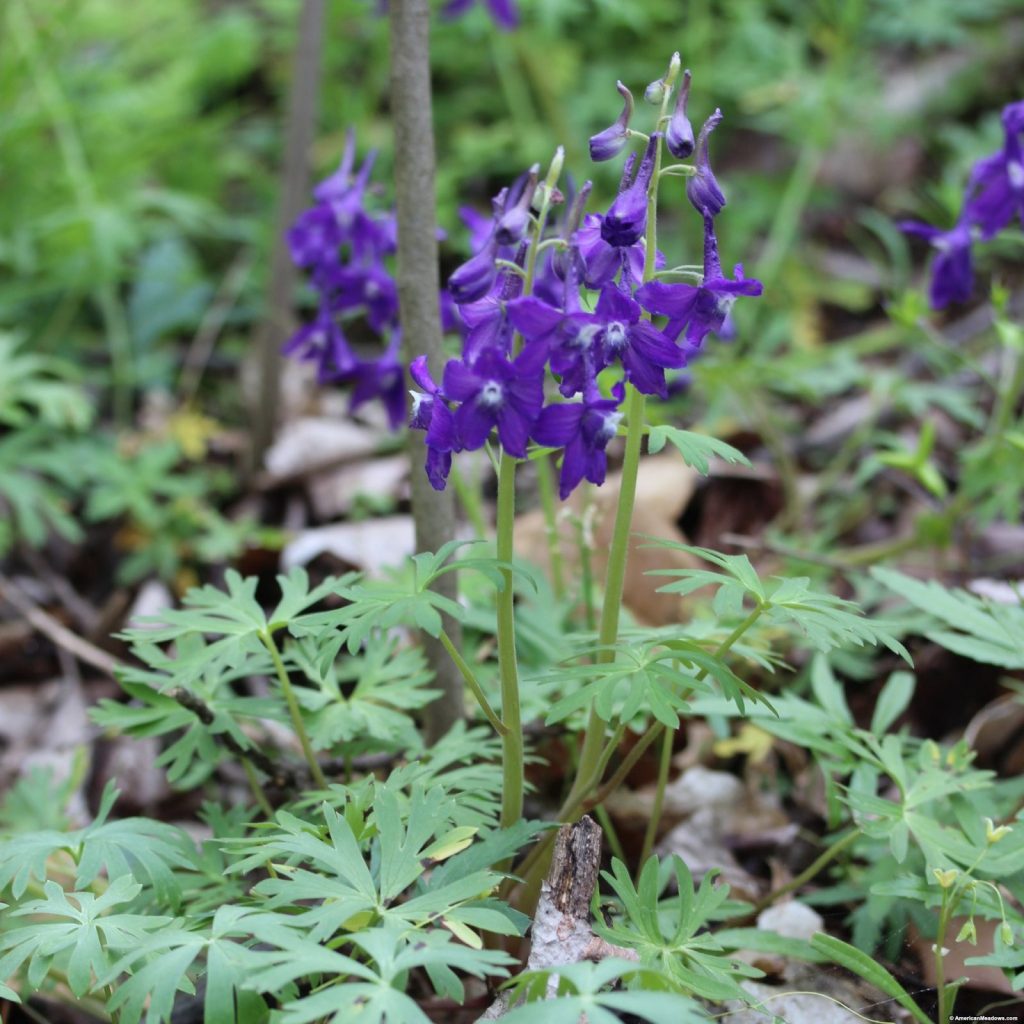
Bee friendly Dwarf Larkspur has uniquely-shaped, deep-purple blooms early to mid Spring. Dwarf Larkspur grows in zones 4 to 8 in part Sun and part shade and reaches 12 to 24 inches tall. Native Dwarf Larkspur is a magnet for both hummingbirds and queen bumblebees, who are two effective pollinators. Ideal for border edges, woodland settings, small spaces, or small space gardens. Attracts both butterflies and hummingbirds and can be used for cut flowers.
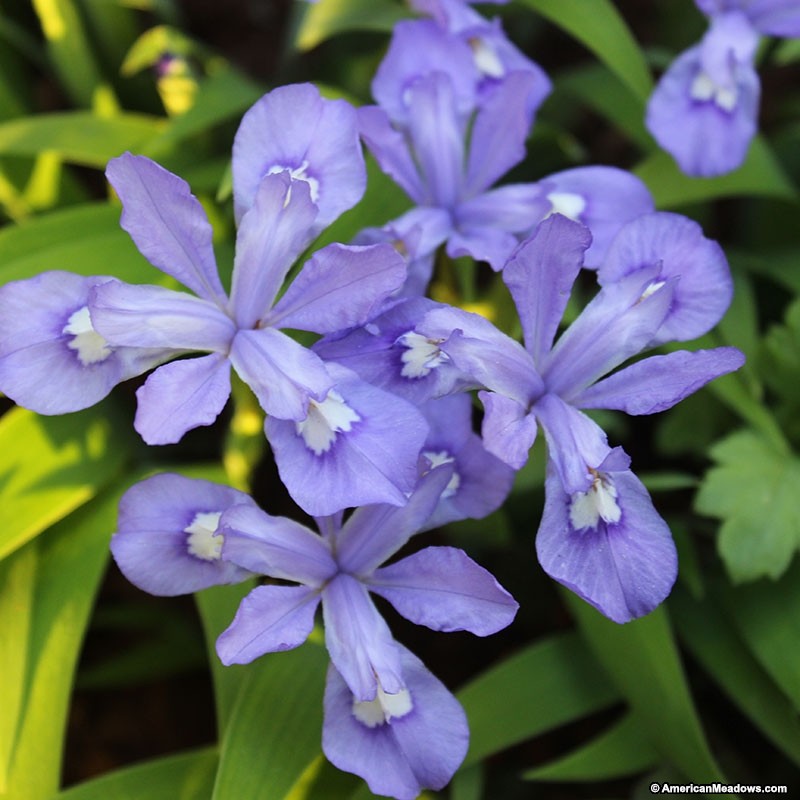
Bee friendly Dwarf Crested Iris or Iris Cristata has vigorous lilac blue blooms on low growing, deer-resistant foliage. Dwarf Crested Iris grows in zones 5 to 8 in part Sun and part shade to full shade. Grows between 4 to 8 inches tall with blooms appearing early to late Spring. Deer resistant Dwarf Crested Iris can be used in rock or woodland garden settings. Ideal for use in garden beds, borders, groundcover, small spaces, and small space gardening.
35. Wild Spiderwort
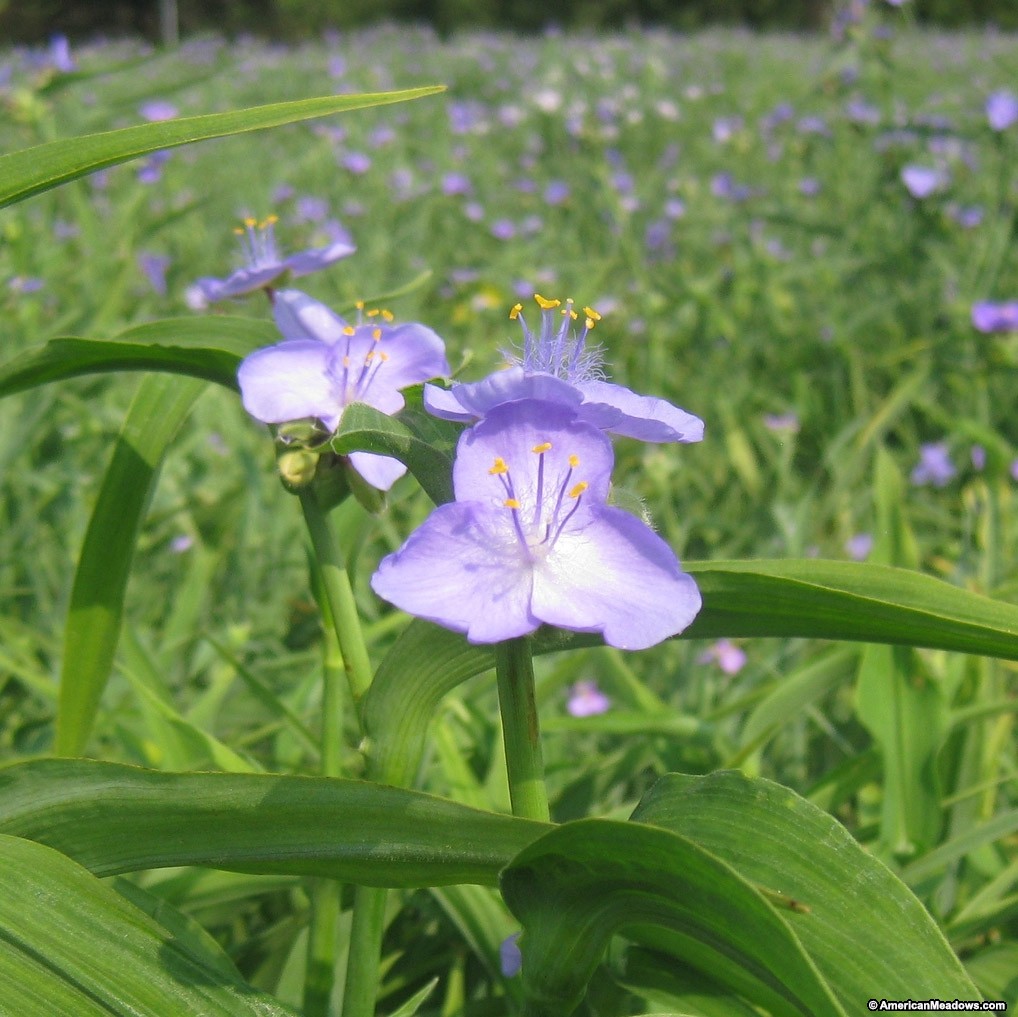
Bee friendly Wild Spiderwort has purple petals with stamens and chartreuse anthers that bloom in late Spring to early Summer. Wild Spiderwort grows in zones 5 to 9 in part Sun and part shade to full shade. Tops out at 12 to 24 inches. Easy to grow Wild Spiderwort has arching, grass-like foliage, that will spread. Ideal for edging beds and prefers moist soils. John Tradescant, the British plant explorer, discovered Wild Spiderwort. Mr. Tradescant arrived early in America. He gained popularity for the New World plants that he return to England with.
Final Thoughts . . .
These are 35 North American native plants to help you create a Wildlife sanctuary. Creating a wildlife sanctuary in your garden no matter how small, will pay off in many ways. A garden for wildlife will become a haven for the many pollinators that have lost its food sources due to the decrease of woodlands and forests. If you try any of these native plants to build a Wildlife sanctuary in your garden, let us how you make out. We’d love to hear about your garden Wildlife sanctuary.
For information on a DIY home address project, see our post for a street address sign. Motivated by our local Fire Marshal’s reminder to always have a clearly visible address sign in the event of an emergency. See our post – Coastal DIY: Mid-Century Modern Address Sign.
For information on birdhouses to buy or build, see our post 10 Blissful Birdhouses to Attract Birds That Serenade or for Fall annuals to plant now, see 8 Fantastic Annuals to Plant This Fall. If you have any questions, feel free to reach out to us in the comments below. We always are ready to help you out.

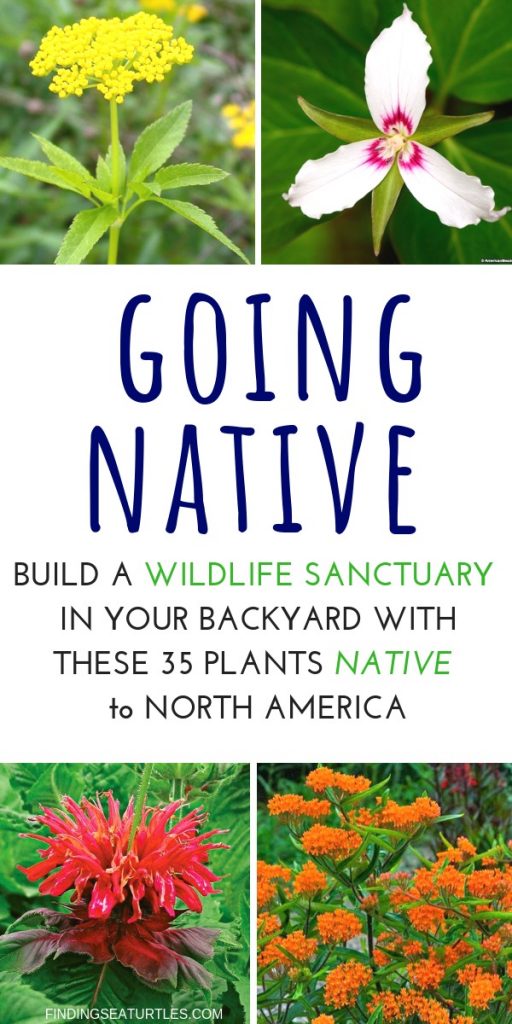
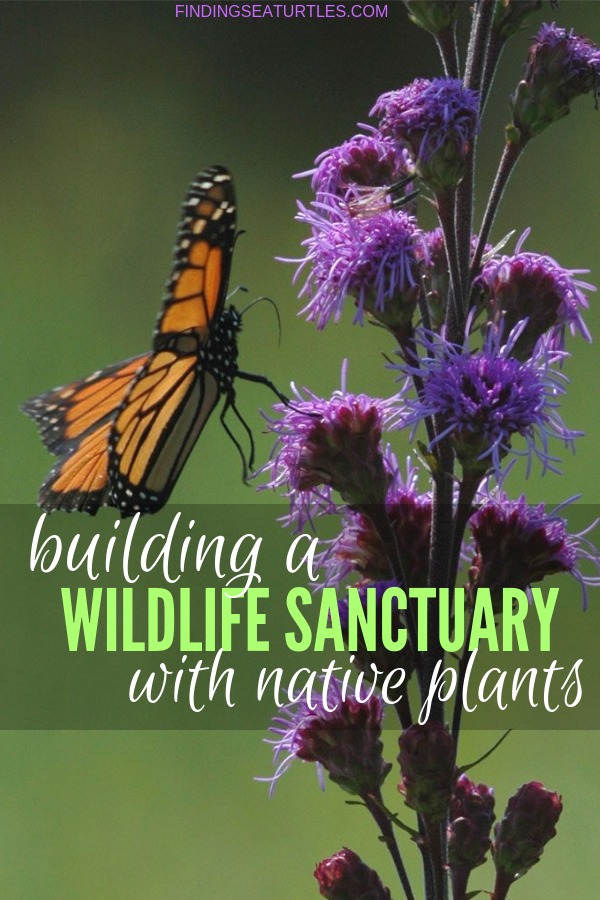
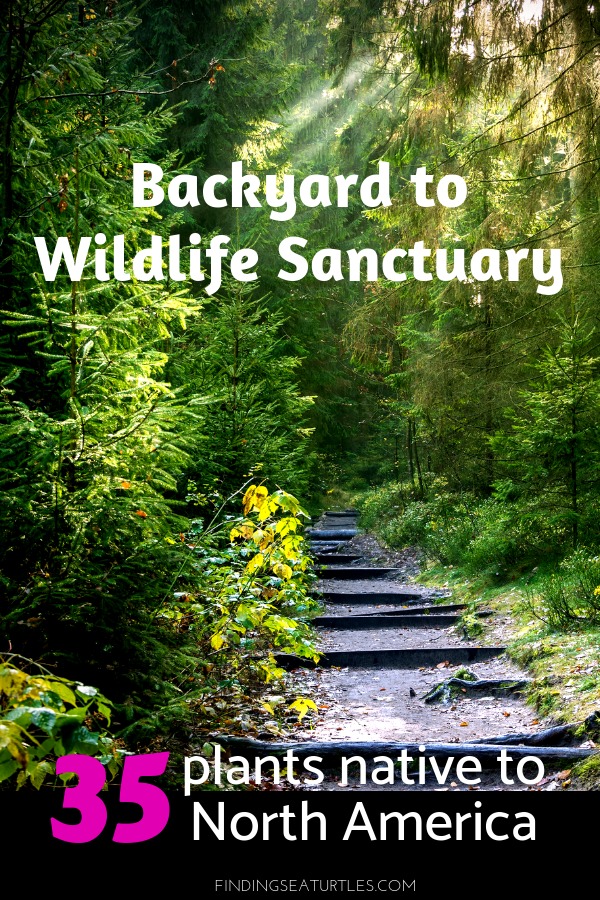
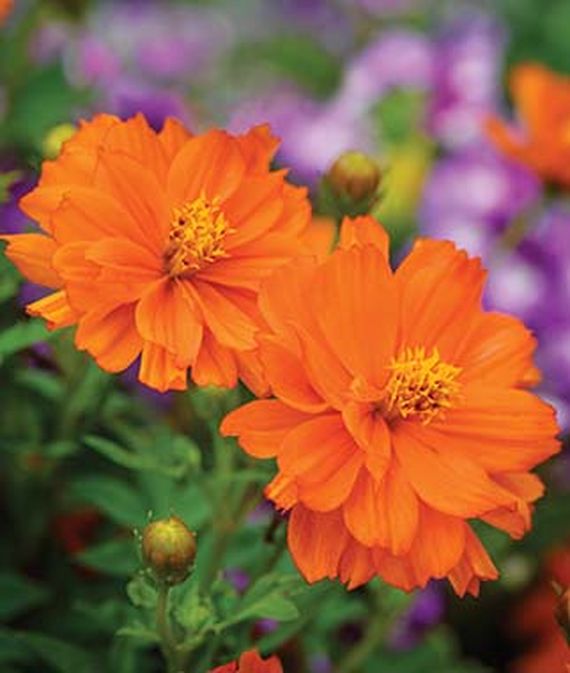

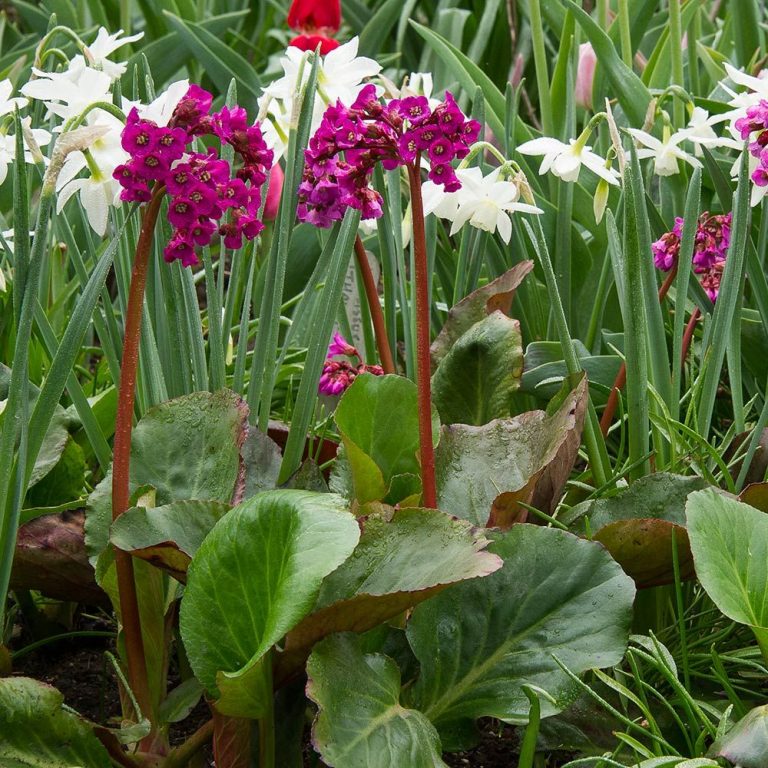
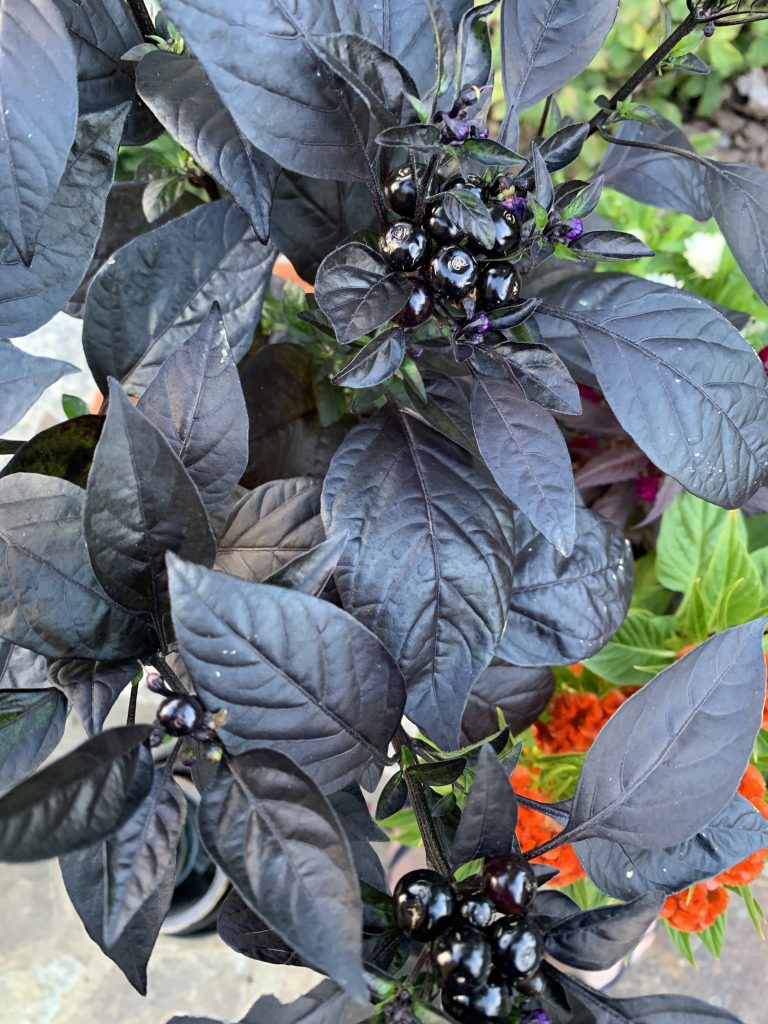
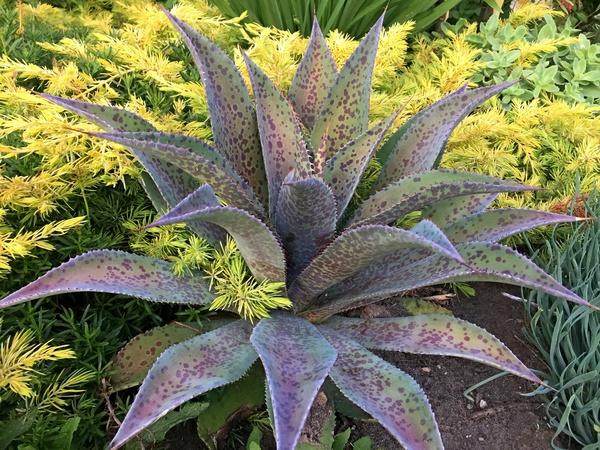
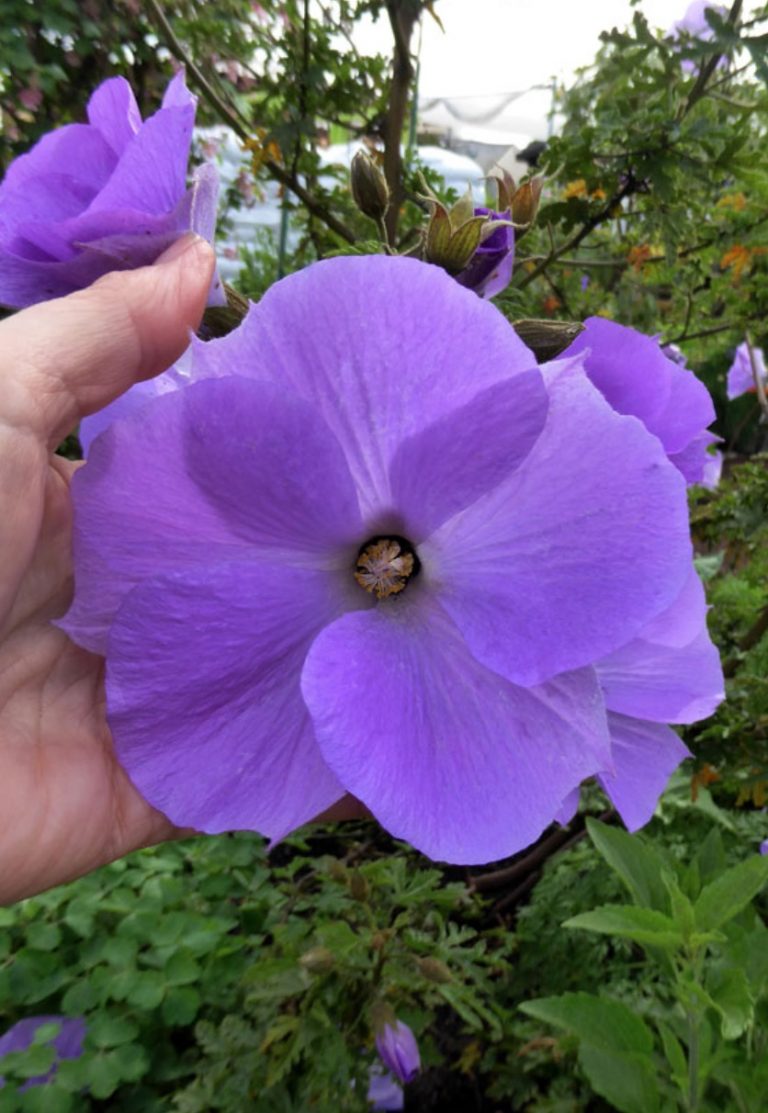
This is a super great list and includes many of my favorites for supporting pollinators. I would only say that some of the cultivars pictured (like the coneflower) have been bread to be beautiful and unique looking to humans. Which is great- we should love our gardens! But some cultivars aren’t favored by pollinators and may contain very little pollen or nectar to forage upon. A garden that mixes the natural, wild version of plants plus a few really unique cultivars is a great way to appeal to animals and us gardeners at the same time!
Where is the best time to plant this native plants and where can I Buy the seeds and grown plants?
Hi Melissa, I’m not sure what zone you live in. One good source is Prairie Nursery in Newton, WI. They sell both seeds and plants that are native plants. Another source is Prairie Moon Nursery in Winona, MN. Hope this helps. And good luck. Happy Gardening! Mary
Hello Melissa, Another though is there are Arbor Day sales and Mother’s Day Sales that you can buy plants for less. I have a post called “Money Saving Garden Tips for the Frugal Garden” – see item number #15. Again, not sure of your location or zone but one place that sells native plants is at the University of Wisconsin – Friends of the Arboretum Madison, WI. They have an annual native plant sale the weekend before Mother’s Day. And I believe you can pre-order some plants. – good luck! Mary
Melissa, I have purchased many plants over the years. Every plant from Prairie Nursery has thrived and is reliable to return the following year. Some plants I have purchased through community sales have become invasive, introduced new weeds to my gardens and were in general unwelcome. I wish you the best. Happy gardening!!! ?